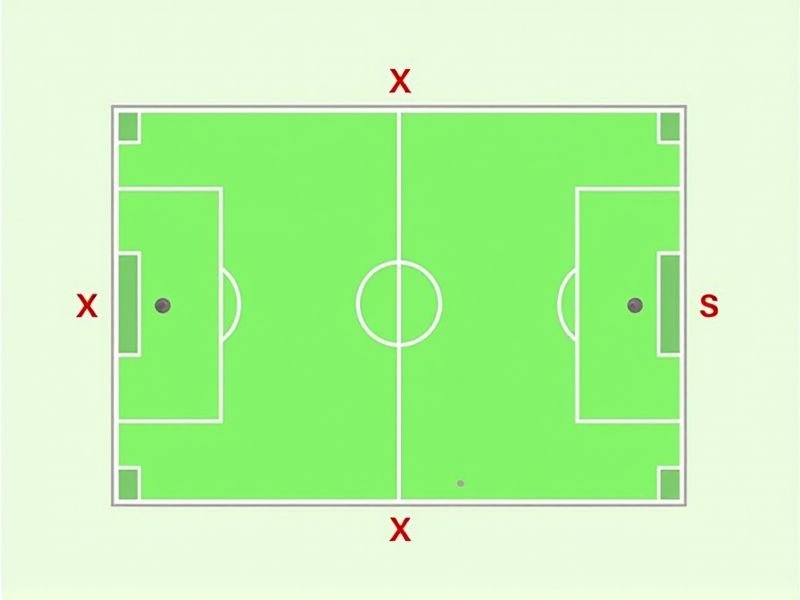
The standard dimensions of a soccer field, as recommended by FIFA, are typically between 100-110 meters (110-120 yards) long and 64-75 meters (70-80 yards) wide for international matches. However, the exact size can vary depending on the level of play and available space, especially for non-international games. For example, youth soccer fields may be smaller to accommodate younger players and promote skill development. Knowing the standard field size helps with planning practices, setting up games, and ensuring a fair, consistent playing environment across different venues.
Touchline Length: 100-110 Meters
The standard touchline length of a soccer field ranges from 100 to 110 meters, making it essential for maintaining the integrity of the game. This measurement is part of the overall field dimensions regulated by FIFA, which also dictates a width between 64 to 75 meters. Ensuring your field adheres to these specifications can enhance playability and meet professional requirements. Proper dimensions contribute to consistent gameplay and optimal player performance at all levels of competition.
Goal Line Width: 64-75 Meters
The standard width of a soccer field's goal line spans from 64 to 75 meters, ensuring that it meets FIFA regulations for international matches. This measurement significantly influences gameplay, affecting strategies employed by teams and the average distance players cover during a match. A wider goal line can promote a more open style of play, allowing for greater ball movement and tactical formations. Understanding these dimensions can enhance your appreciation of the sport and its organized structure.
Center Circle Radius: 9.15 Meters
The standard center circle radius on a soccer field is 9.15 meters, delineating the area from which players must remain during a kick-off. This measurement ensures that all opposing players are positioned at least 9.15 meters away when the game starts or resumes. This regulation not only promotes fair play but also provides a structured approach to restarting the game, maintaining the flow and intensity. Understanding these measurements is essential for players and coaches to strategize effectively during set pieces.
Penalty Area Length: 16.5 Meters
The penalty area in soccer, also known as the 18-yard box, measures precisely 16.5 meters in length. This critical zone dictates the location where fouls committed by defenders can lead to penalty kicks. The width of the penalty area spans 40.3 meters, providing a significant space for scoring opportunities. Players must understand the importance of positioning within this area to maximize their chances of success during matches.
Penalty Area Width: 40.3 Meters
The penalty area width of a standard soccer field measures 40.3 meters, providing a crucial zone for defensive and offensive plays. This area, also known as the 18-yard box, is integral in determining the placement of the penalty kick spot, which is located 11 meters from the goal line. The dimensions ensure that goalkeepers have a defined space within which they can operate during set plays and penalties. Understanding these specifications can enhance your appreciation of the strategic elements involved in soccer gameplay.
Goal Area Length: 5.5 Meters
The standard goal area length of a soccer field is precisely 5.5 meters, providing a designated space directly in front of each goal. This area plays a crucial role during goal kicks, as the ball must be placed within this region to resume play. Understanding the dimensions of the goal area enhances your soccer strategy, particularly for set pieces and defensive positioning. In total, the goal area measures 18.32 meters wide, further emphasizing the importance of this critical zone on the field.
Goal Area Width: 18.3 Meters
The standard soccer field includes a goal area with a width of 18.3 meters, playing a crucial role in game dynamics and strategies. This area is essential for goal kicks, where players must ensure the ball is restarted within this defined width. For your understanding, the goal area extends 5.5 meters into the field from the goal line, highlighting its significance during defensive plays. This specific measurement aids referees and players alike in maintaining the integrity of the game.
Penalty Spot Distance: 11 Meters
The standard soccer field features a penalty spot located precisely 11 meters from the goal line, making it a crucial element in penalty decisions. This distance is designed to give the goalkeeper and the penalty taker a fair chance during a one-on-one confrontation. Understanding this measurement is vital for players and coaches, as it influences strategies during critical game moments. Adhering to these dimensions ensures that the game maintains its integrity and competitive nature.
Corner Arc Radius: 1 Meter
The standard soccer field features a corner arc with a radius of 1 meter, ensuring uniformity across playing surfaces. This corner arc is integral for defining the area where corner kicks are taken, allowing for a clear and consistent starting point for plays. Each corner arc helps maintain the integrity of the game by providing specific spatial dimensions, promoting fair play and accuracy. Understanding this detail enhances your appreciation of the game's regulations and field design.
Goal Size: 7.32 Meters Wide By 2.44 Meters High
The standard size of a soccer goal measures 7.32 meters in width and 2.44 meters in height, creating a precise target for scoring. This dimension is crucial for maintaining uniformity across professional and recreational matches. A standard soccer field typically features goalposts made from sturdy materials like aluminum or steel, ensuring durability during play. Understanding these specifications is essential for players, coaches, and officials to maintain the integrity of the game.
